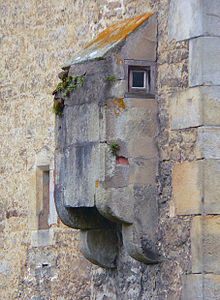Aborterker

The Aborterker (also: Abtritterker ) is a bay window that served as a toilet in a castle or on a residential building in the Middle Ages . The lavatory prison is often confused with the military prison .
The lavatory shaft was a structural variant . These were also sometimes used on ships; One example of this is the wreck of the Vasa , which was raised, preserved and exhibited in the 1960s , with two drainage shafts on the front deck that extend below the ship's waterline.
execution
There were both brick and wooden toilet dungeons; they were mostly rectangular, but could also be semicircular in individual cases. They rested on side corbels or consoles . In a castle, below the bay window, a long wooden - and occasionally brick - shaft often led away the excrement into the moat .
Toilets in medieval fortifications
The simplest type of drainage consisted of a pit in the ground, which often seems to have been only about 30 centimeters deep. In Central Europe, these primitive abortions were mostly bricked up or carved into the rock. Such systems have rarely survived. Otto Piper mentioned in his castle studies, for example, the resignations in the mountain peace of Steinsberg Castle in Baden and the Württemberg Castle Morstein .
Somewhat more advanced systems of this type were located within the outer wall and were connected to the interior of the building by a short corridor ( Gutenfels Castle , Rhineland, Spesburg Castle in Wasgau).
A clear improvement in the hygienic conditions was brought about by toilets in wall niches, the manholes of which led outwards at an angle. The feces could fall into the moat or into the open area, the shaft no longer had to be emptied regularly.
In the next stage of development, the outflow openings of the drainage shafts protrude over the wall surface, but the actual outlet is still in the wall. At the Palas of Burg Liebenzell an exit port has received about half a beehive in shape.
In the late Middle Ages, the fully developed abortion bay, in which the seat is completely housed in the bay, prevailed. There are a surprising number of such systems in many castles. After Otto Piper great to Ganerbenburg Eltz have had on the Mosel even 14 garderobe.
Large garrison castles such as the facilities of the Teutonic Order sometimes required, in addition to the described smaller abortion facilities, their own abortion towers, which were separated from the actual castle complex . The ideal was the installation of such a " Dansker " over a river. The most elaborate example of such a toilet tower is the Dansker in Marienwerder , which, however, in its preserved form is a reconstruction of the 19th century.
Litter box of the Red Tower of the Palatinate in Wimpfen
Aborterker der Burg Posterstein
Aborterker at the castle camping
Interior view of the lavatory at the Obertagstein ruin
Interior view of the lavatory at Hoensbroek Castle
Lavatory at the Hülsede moated castle
Others

An unfavorably located medieval or early modern toilet facility could be a dangerous weak point in the fortifications. So allegedly invaded in 1204 some besieged by the abortion shaft into the Kapellenbau the inner bailey of the castle Gaillard one on the Seine. The unfortunate Duke Gottfried the Hunchback of Lorraine was even murdered in 1076 on the cesspool. His murderer allegedly (according to Lampert von Hersfeld ) stuck a sword through the opening of the lavatory into his abdomen.
Abortion facilities in residential buildings

In urban residential areas, lavatory bays led either to the back of private property, into a river, or into an alley between two houses that was rarely used or not used by pedestrians. This explains the nickname "Köttelgang" for narrow streets.
literature
- Dieter Barz: From lavatory shaft to lavatory bay - on the construction of latrines in castles and fortifications in the 10th to 13th centuries. In: Olaf Wagener (editor): Abortions in the Middle Ages and the early modern times. Building research - archeology - cultural history. Michael Imhof, Petersberg 2014, ISBN 978-3-7319-0093-1 , pp. 55-65.
- Claudia Birke: Urgency and secrecy. The toilet facility as part of Franconian castles and palaces from the High Middle Ages to the early modern period. In: Castles and Palaces . Volume 48, No. 3, 2007, ISSN 0007-6201 , pp. 144–151.
- Horst Wolfgang Böhme : lavatory, facility, bay, shaft. In: Horst Wolfgang Böhme, Reinhard Friedrich, Barbara Schock-Werner (Hrsg.): Dictionary of castles, palaces and fortresses. Philipp Reclam, Stuttgart 2004, ISBN 3-15-010547-1 , pp. 63-65.
- Karl-Heinz Dähn: Nezessaries. In: Castle history hikes in the Heilbronn area. Series of publications from the district of Heilbronn. Volume 5. Heilbronn 2001, ISBN 3-9801562-5-7 , pp. 67-81.
- Otto Piper : Castle studies - construction and history of the castles. Piper, Munich 1912, pp. 488-491 ( digitized version ).
- Joachim Zeune : Castles - symbols of power. A new image of the medieval castle. Regensburg 1997, ISBN 3-7917-1501-1 .
See also
- Dansker , tower-like lavatory at castles.
Web links
Individual evidence
- ↑ see Otto Piper: Burgenkunde - Building and History of Castles. 3rd edition 1912, pp. 486-487 in the Internet Archive
- ↑ see Otto Piper: Burgenkunde - Building and History of Castles. 3rd edition 1912, p. 489 in the Internet Archive





